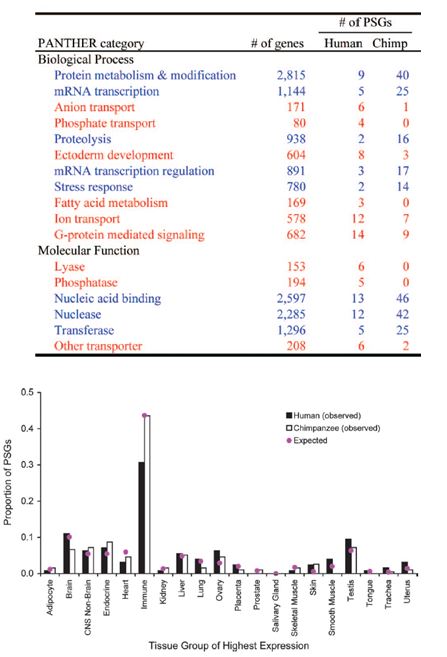Every so often, it’s good to see something clearly illustrating that it’s not all about us, that evolution doesn’t simply progress its way up a ladder, climbing ever higher until it reaches humans on the top rung.
Genetic comparisons offer one such clear illustration.
For example, now that we’ve fully sequenced the human and chimpanzee genomes, we can take a close look at the different paths our genes have travelled during the six or seven million years since we parted ways from a common ancestor. In that time, humans and chimpanzees have plainly diverged quite a bit — on the one hand, humans have learned to walk on two legs, experienced dramatic growth in brain size, and now excel at speech, language and a whole host of cognitive functions; on the other hand, although chimpanzees are clearly intelligent primates, they still retain many of the physical and behavioral characteristics that they had millions of years ago.
Obviously, then, our genes have undergone the greater process of Darwinian natural selection … right?
Wrong.
The Human-Chimpanzee Genome Comparison
A team of researchers led by Margaret Bakewell and Jianzhi Zhang of the University of Michigan1 decided to systematically compare the human and chimpanzee genomes to find out which species’ lineage has undergone more positive Darwinian selection over time. In essence, they lined up the two genomes to identify where they differed, and then used the DNA of the rhesus macaque, which shares an older ancestor with each of us, to figure out whether differences were due to changes in the human or in the chimpanzee DNA.
Moreover, since some DNA changes have no impact on protein production, the team was able to use statistical methods to look at the changes that do impact protein production and identify which of these were positive in the sense that they conferred a survival or reproductive advantage. (Without getting into the mathematical details, genes where a disproportionate number of the DNA changes do impact protein production are the ones where positive selection is taking place.)
In all, the researchers scanned nearly 14,000 genes (greater than 50% of the genes in the primate genome), and carefully controlled for relatively quality differences in the available genomic sequences. Using their most conservative data, they identified 154 genes that were under positive selection in the human lineage and 233 in the chimpanzee lineage. In other words, chimpanzees have 51% more positively-selected genes than humans have.
The research team summed up these findings:
[I]n sharp contrast to common belief, there were more adaptive genetic changes during chimp evolution than during human evolution. Without doubt, we tend to notice and study human-specific phenotypes more than chimp-specific phenotypes, which may have resulted in the prevailing anthropocentric view on human origins.
Interestingly, the types of genes undergoing positive change are not particularly correlated to the areas where we have seen the greatest physical divergence, such as brain size. Rather, as the below charts indicate, the areas of positive selection are widely distributed through biological processes, molecular functions and tissue groups (in the charts, PSG stands for “positively selected gene”) :
What Explains the Greater Positive Selection in Chimps?
The researchers believe that the principal explanation for the findings is that, for most of the time that humans and chimpanzees have evolved separately, the average population size of chimps was 3-5 times as large as that of humans. This is significant, as population genetic theories predict that positive selection is less effective in smaller populations (i.e., in a small group there are simply fewer opportunities for the occurrence of beneficial mutations with survival and/or reproductive advantages).
Now, there are a few caveats to this story. For one, this type of comparison does not necessarily capture recent or ongoing changes that are not yet “fixed” in the genome, so recent positive changes to the human genome may have gone undetected. Also, while this analysis adds up the relative number of genes undergoing positive change, it does not take into account the fact that some changes may be more important than others, as a change to a single gene can sometimes have a dramatic impact. Also, the study focuses on changes to genes that impact the proteins that they produce, but not the way in which those genes are expressed (e.g., whether and when the genes are turned on or off), and gene expression can account for very significant differences between species.
Nevertheless, even with these caveats, this study is an eye-opener.
From a human perspective, we naturally see our distinguishing characteristics as critically important, and often assume that they reflect something special from an evolutionary standpoint. When we look closely, though, we sometimes find that our views are far more subjective than objective. From a broader perspective, we have been just a single species with (for most of our history) a relatively small population, and have accordingly undergone a correspondingly slower rate of natural selection.
Makes one wonder whether the chimps, with all of those positive genetic changes, could have evolved a way for handling debt ceilings and political consensus. Now that would be an adaptation that would come in handy these days!
_____
1Bakewell, M., Shi, P., & Zhang, J. (2007). More genes underwent positive selection in chimpanzee evolution than in human evolution Proceedings of the National Academy of Sciences, 104 (18), 7489-7494 DOI: 10.1073/pnas.0701705104



Shirley M
/ May 19, 2023This was a lovely blog posst